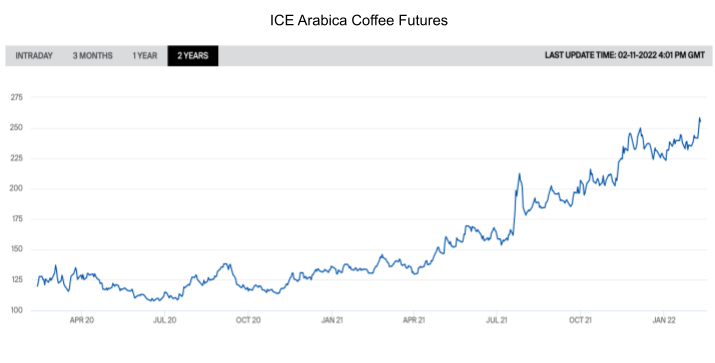Climate Change Can Impact Your Morning Cup of Coffee

Coffee - one of the most popular breakfast drinks in the world is very vulnerable to the changing climate. In 2021, coffee production was impacted by droughts, frosts, and changes in temperatures, resulting in lower global output. According to the estimates of USDA, in the marketing year (MY) 2021-22, the world coffee production will record a YoY decline of roughly 5% which is 8.5 million fewer bags than the volume produced in the previous MY. The lower production will reduce the global ending inventories of coffee and further push down the export volumes from major coffee-producing countries.
A recent study undertaken by researchers at International Coffee Organization (ICO) predicts that there will be a decrease in the total land area that is suitable for growing coffee by 2050. Currently, the majority of the coffee-producing countries are located in Central and South America, especially Brazil, in Central and West Africa, and in parts of South and Southeast Asia that have suitable agro-climatic conditions throughout the year to support coffee production. However, the study suggests that the top 4 coffee-producing countries - Brazil, Vietnam, Colombia, and Indonesia - will record a decline in the area available for growing coffee due to extreme climate change. Such events include an increase in mean annual temperatures and unexpected rainfall patterns. Only Ethiopia, which is the native home for the coffee bean and the fifth largest producer, will retain its position on the global map. It is expected that countries outside the tropics are likely to become more suitable to grow coffee and find new export opportunities to profit from the plant.
In 2021, the top three producing countries - Brazil, Colombia, and Indonesia - recorded a notable fall in coffee production due to extreme climate change events. The subsequent drought and frosts in Brazil hampered coffee production; CONAB, a Brazilian agricultural crop agency, estimated that Brazil's Arabica coffee crop was set to fall by 36% from 48.8 million bags in 2020 to 31.4 million bags in 2021. Colombia was severely affected by heavy rains due to the La Nina phenomenon and as per Colombia's National Federation of Coffee Growers (FNC), the country's 2022 coffee crop could record a YoY fall of 7% due to heavy rains damaging crops. Similarly, in Indonesia, the high intensity of rains and strong wind during the main coffee growing season disturbed the growth of the plant and reduced its yield. The lower harvest has reduced the overall projected production for arabica coffee by 20,000 bags.
The ICO study also acknowledges the impact of climate change on the production of cashew and avocado as they have similar ecological niches, but claims that coffee was the most vulnerable to climate change. Without any doubt, coffee is already a commodity high in demand and the prices will also significantly rise if the production continues to fall. The impact of lower production was even made evident in 2021 with the ICE coffee futures price climbing throughout the year and breaking a two-year record. The outlook for MY 2021-22 remains bleak with lower coffee production and the lingering impact of extreme climate events. To return to business as usual, there is a need to approach coffee production in a more climate-resilient and sustainable manner.

Source: ICE.






